How To Generate Qualified Travel Leads With Google PPC Advertising
If you are a small travel operator just starting out or an established travel company looking to scale, then Google Pay Per Click (PPC) advertising is undoubtedly one of the fastest ways to validate your tour offering and generate leads.
However, if you don’t know what you are doing with PPC, you can very easily spend loads of money and have nothing to show for it.
In this article we look at how you can get great returns from Google advertising.
By the end of the article you will know:
1. How to generate affordable and qualified traffic using Google Adwords.
2. How to optimize your Google PPC campaigns for low cost per clicks and high click through rates.
3. How to identify underperforming campaigns and minimize wasted budget.
Reading Time: 15 Minutes
PPC Advertising 101
Pay-per-click (PPC), also referred to as cost per click (CPC), is an Internet advertising technique where an advertiser pays a publisher a small fee when an ad is clicked.
The most powerful form of PPC advertising is Google Adwords – i.e. the search and display ads you see when searching on Google or browsing web publications.
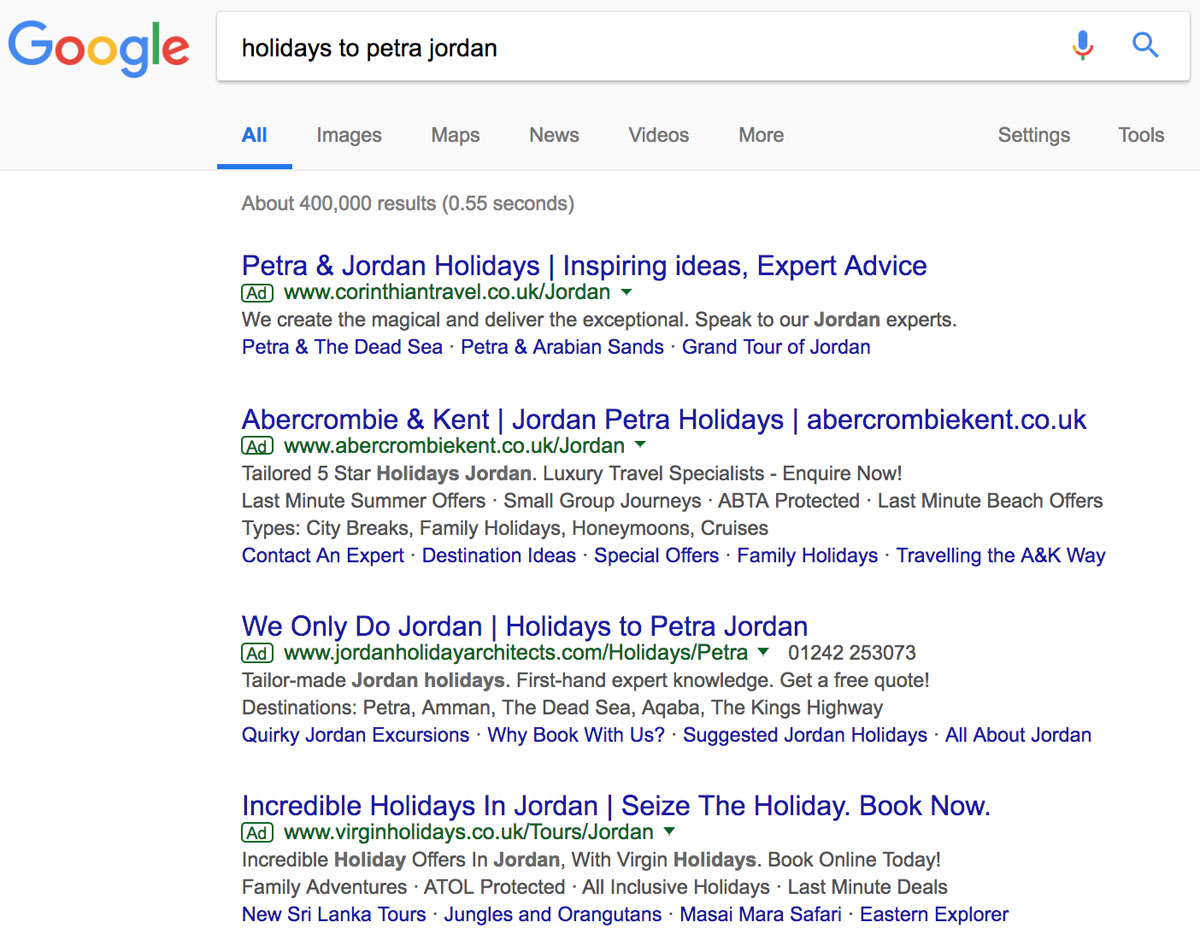
However there are many different PPC advertising services, like Media.net, Revcontent, Chitika and Clicksor that offer similar advertising services.
Moreover, social media networks like Facebook, Instagram and Linkedin also offer PPC advertising services.
For the purposes of this article we will be focusing on the most popular PPC model, Google Adwords, but we will return to Facebook advertising using PPC in the next chapter.
Google Adwords and PPC Advertising
The reason for Google’s dominance in PPC advertising is actually quite obvious – Google has a huge share of the search market and offers advertisers laser-focused placement.
According to Statcounter, Google has over 91% of the global search engine market. To put that into perspective, Google processes over 3.5 billion searches a day.
As we established in our article on Search Engine Optimization, every search broadly fits into three main buckets. Navigational searches, like “Nike” or “Samsung Customer Service” help users find a particular site. Informational searches, like “How to choose a rail trip in India” or “Where is Boracay” help a user acquire information. Transactional searches, like “Buy tickets to Tokyo” or “Cheap hotel deals in Nairobi,” imply the visitor wants to undertake a transactional activity.

Transactional searches are incredibly important for PPC as they help advertisers establish commercial intent.
Google’s PPC advertising offer, Adwords, offers advertisers the opportunity to bid via a dynamic auction for placement in search results for high commercial intent keywords.
The auction nature of Adwords works in the same way as a traditional auction in the sense that keywords that have high intent and lots of advertisers cost more per click than keywords with lower intent and less advertisers.
Google offers up to 4 top spots on a search result, as shown below, with the first spot costing more per click than the one below it, and so on.

For example, a travel company offering tours to South Africa can use Adwords to place search advertisements for the keyword, “South Africa Honeymoon Packages”.
There are a lot of technical elements to PPC advertising, but for travel companies just getting started on Adwords, understanding two key areas will put you ahead of most competitors and ensure you get a positive ROI from PPC.
They are:
- The PPC Hierarchy of Needs
- Retargeting
Let’s look at each.
The PPC Hierarchy of Needs
It is very easy to get overwhelmed with PPC advertising. There is a dizzying amount of new terminology to learn, loads of technical nuances and many moving parts to an advertising campaign.
To help cut through the complexity, a very useful model to understand is the PPC Hierarchy of Needs. The hierarchy sets out the structure and order of an effective PPC campaign. Master the hierarchy and you will very quickly go from negative ROI to being very profitable.

The hierarchy starts with account structure. This is where you get the setup of your campaign right. Once the structure is in place, the task is to decide which high commercial intent keywords to target.
The keywords inform the content of the landing pages on your website, where you will be sending traffic to, and the ad copy that Google users, aka your potential customers, will see.
The campaign sits within a dynamic environment that is continually evolving. This means analytics and performance evaluation for continual improvement is key.
Account Structure
The structure of your ad account sets the foundation upon which you build a successful PPC campaign.
In the case of Google Adwords, the structure consists of Campaigns, Ad Groups and Keywords. Campaigns consist of Ad Groups, and Ad Groups consist of Keywords, as illustrated below.
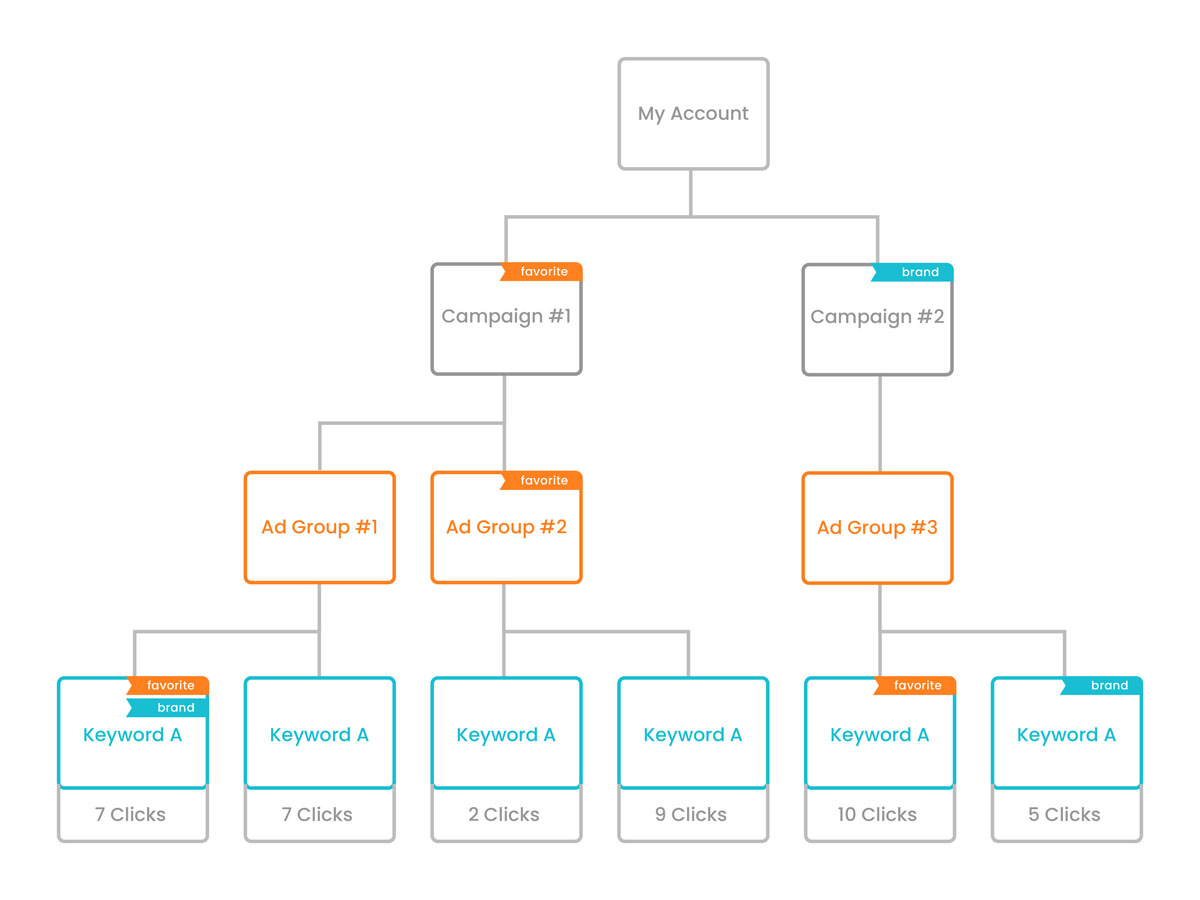
Alignment of these three structural elements inside your account is the first critical step towards successful PPC advertising.
Google allows advertisers to create various ad campaigns across its network. These include Search, Display, Shopping, Video and Apps.

If you are just starting out with Google Adwords, then the safest bet is a Search Campaign as it is a lot easier to ensure ads are clearly aligned to keywords in the search network.
Each campaign should have a clear goal, for example, generating traffic, sales or leads. It is possible to create a campaign without a goal, but we don’t recommend doing this.
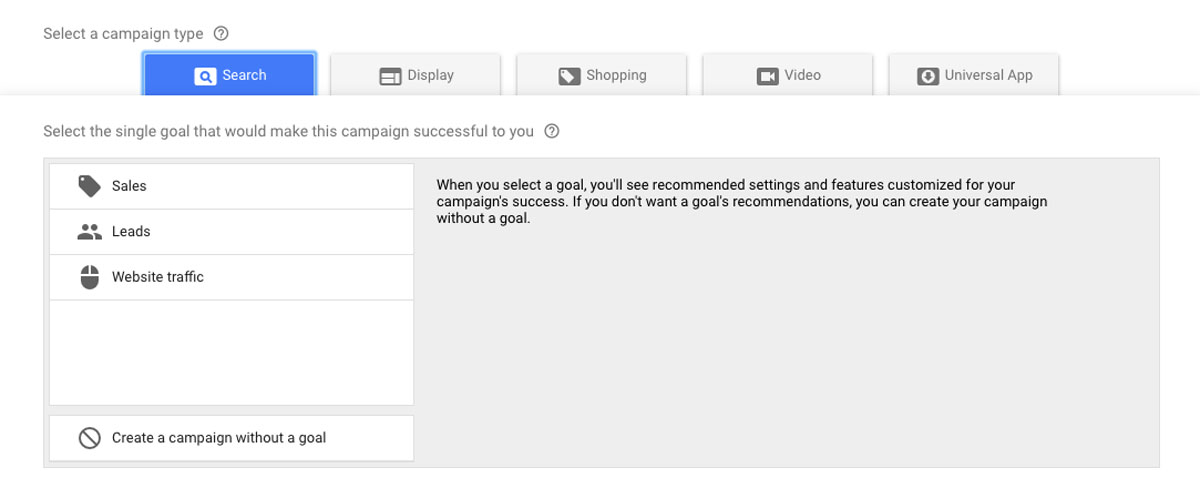
When deciding on a goal, think about what action you want a user to take when they click your ad.
In general, a high value goal, like Sales, requires very high commercial intent keywords like “Buy flights to Lima” or “Book a Lima City Tour”. For travel operators with tour offerings that have some friction in the sales process, optimising for Leads or Traffic can deliver better results.
Once a goal has been set, Google will then walk you through some steps in terms of placement, location targeting, budget and scheduling.
Location is a critical factor and you should think carefully about the location of your target audience.

Google allows advertisers to drive down to great detail in terms of location, but unless you have a highly localised tour offering, then targeting at country or regional level is best.
Once a budget and schedule is confirmed, the next step is setting up Ad Groups.
Ad Groups are effectively themes for the different types of products or services an advertiser offers.
For example, tour operators who offer holidays to South Africa may decide to theme their Ads by the different types of South African holidays they offer – Wine Tasting Tours, Safari Tours, Whale Watching Tours, Honeymoon Tours, Golf Tours, etc.
In general, the more granular you can make your Ad Groups, the more specific you can get with your keywords, ads and landing pages (discussed in more detail below).
The goal in terms of account structure is to get perfect alignment from the Campaign to the Ad Groups, Keywords, Ad Copy and Landing Pages.
QUICK EXERCISE
Consider the tours you currently offer. Define an overarching Campaign for each tour. You might define multiple Campaigns based on different tour features like Country, Activity or Target Audience.
Now think about the Ad Groups in each Campaign. Can you define more granular themes for your tours? List these out.
Keywords
As we saw in the previous article on SEO, keywords are the building blocks of any search marketing strategy.
They inform the intent of the user and define the level of traffic one can expect and the competition associated with that traffic.
In Google Adwords, keywords also define the cost you can expect to pay per click if you were to target them in an advertising campaign.
As mentioned above, keywords should be tightly themed by Ad Group. The issue of alignment can sometimes be problematic, as many keywords don’t have much search volume.
To resolve this, Google will offer up similar types of keywords that have a phrase match or are broadly within the same keyword area. For example, the screenshot below shows Google’s keyword suggestions for the phrase: “wine tasting tours south africa”.
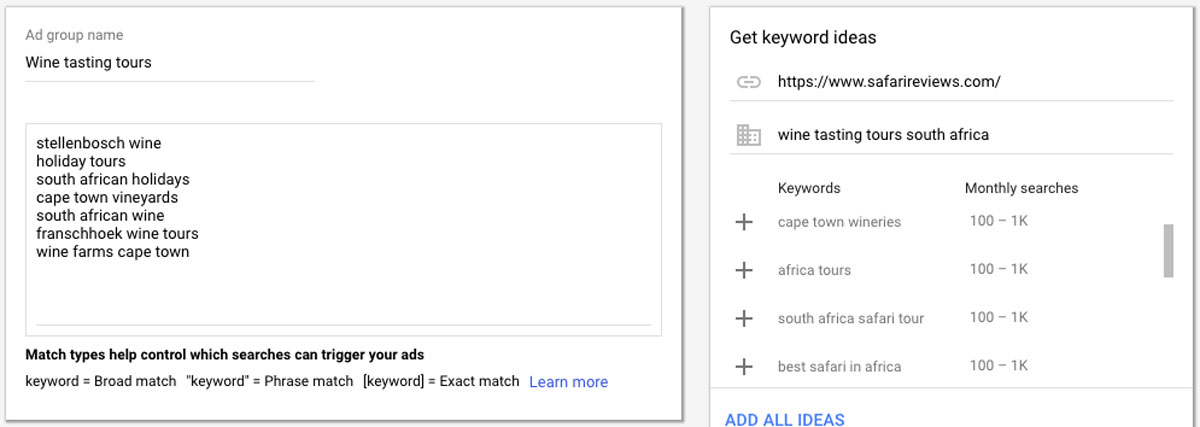
By broadening your keyword’s meaning the reach or volume of search traffic increases, but the intent or relevancy often decreases.
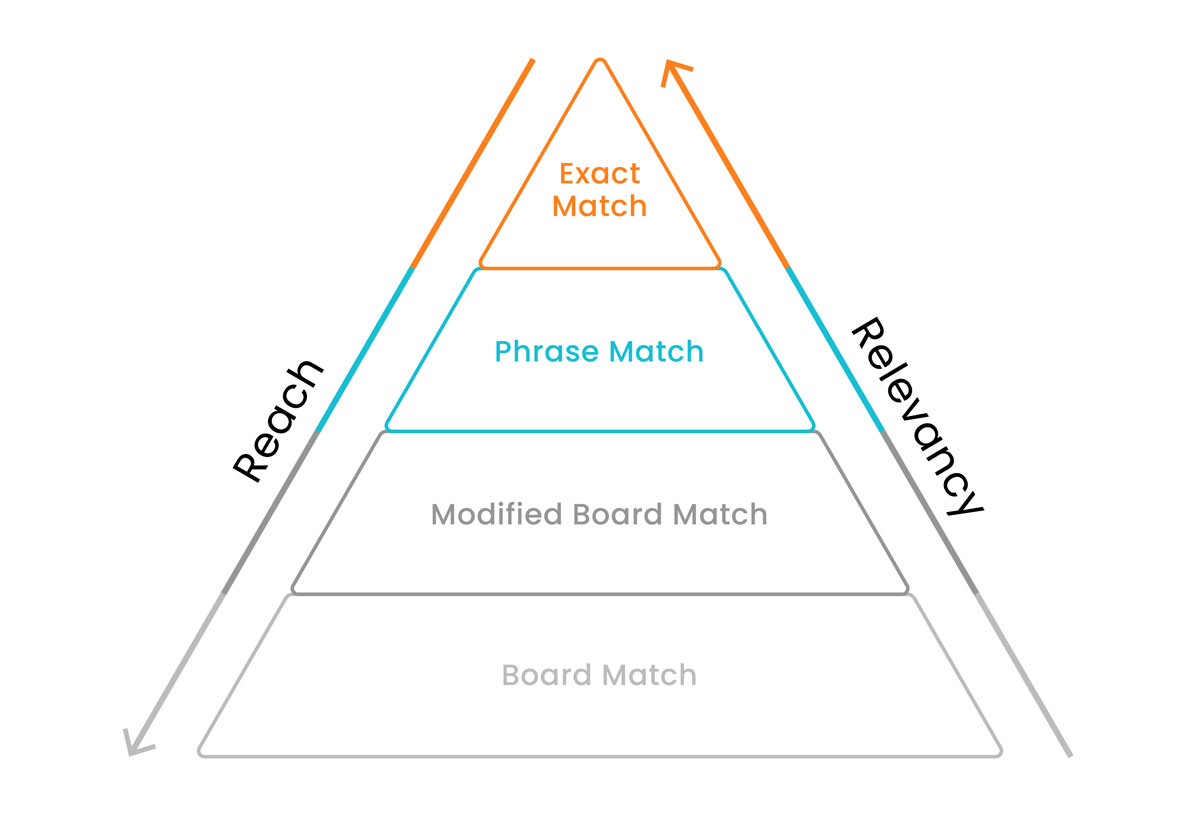
Google allows advertisers to use punctuation to define the match type for keywords:
- Keyword = Broad Match
- “Keyword” = Phrase Match
- [Keyword] = Exact Match
Pro Tip: When starting out, our advice is to stick to exact match only, as broad and phrase match can result in lost expenditure on keywords that don’t have high commercial intent or are not focused enough on your services.
If search volume is very small for your desired keyword, try using a phrase match or modified broad match, and refine your keyword list with negative keywords (i.e. keywords you definitely don’t want to target).
Remember, keywords are where your customer’s journey begins. Make sure you target the right keywords, align them to the right Ad Groups and monitor them regularly to refine and improve your list.
Suggested Reading
- Google Keyword Planner tool is a great resource to discover keywords and get a sense of the cost per click.
Landing Pages
Once you have a tight account structure setup with a clear campaign theme and ad groups targeting well-defined keywords, the next critical step is to align your landing page (i.e. the page you send traffic to), with the ad campaign.
This is where many advertisers fall short. They create a great campaign around a tight theme, but then send their traffic to a poorly designed and irrelevant landing page.
Creating a great landing page is an art and a science, but there are a few key elements that anyone can get right.
Firstly, a landing page needs to look great, both on desktop and on mobile.
A visitor landing on the page for the first time should immediately get a strong sense of your brand and proposition.
Secondly, the messaging on the page should be clear and persuasive, with social signals to establish trust and report.
Finally, the page should have a very clear Call to Action (CTA), be it to fill in a form, make a phone call, download your brochure, sign up to your mailing list, etc.
We cover a lot of these topics in Website Design and Development, but if you feel your current web pages don’t quite cut it for a paid advertising campaign, then we highly recommend you check out landing page services like ClickFunnels, Unbounce and Lead Pages, who offer amazing landing page templates that can be refined, split-tested and used in PPC campaigns.
Here is a great landing page example for travel sites. Notice how it has a clean design, with professional branding and a clear call to action with a special price offering.
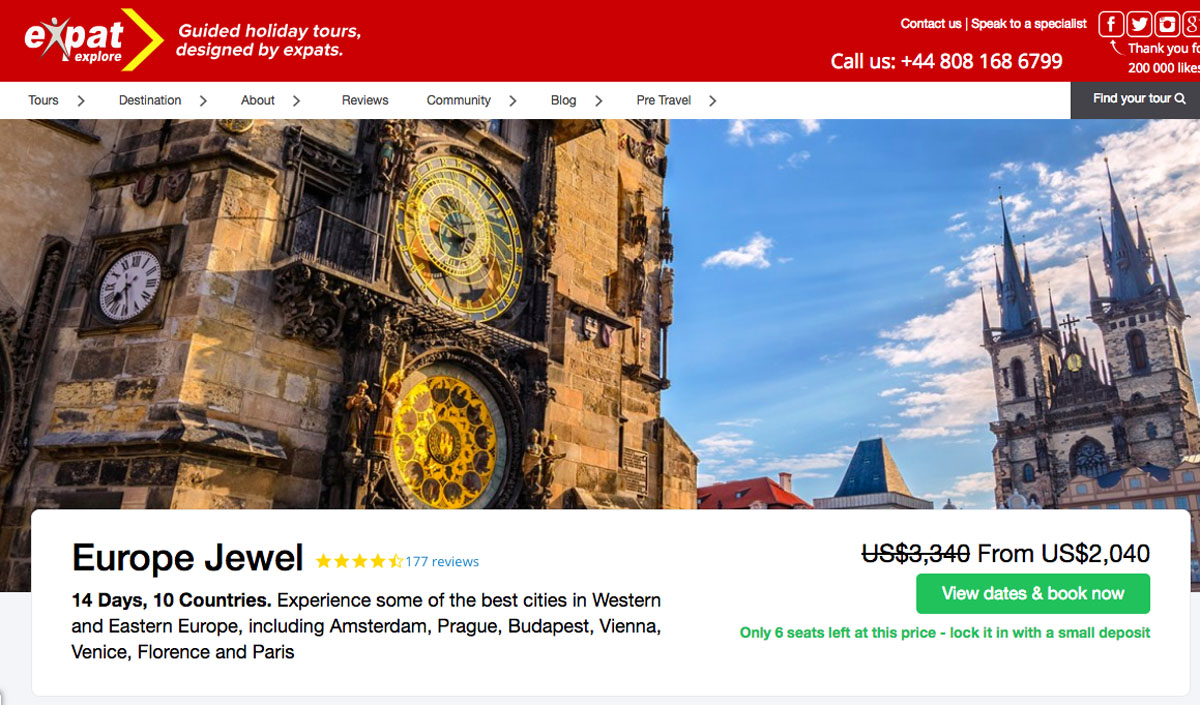
Ad Copy
The ad copy connects the dots between a well-structured campaign targeting a tightly themed set of keywords and a perfectly aligned landing page.
Developing good ad copy can be challenging as you only get a limited amount of space. The headline is typically the most important element and should; like the landing page, be highly relevant to the keywords it is targeting and include a strong CTA.
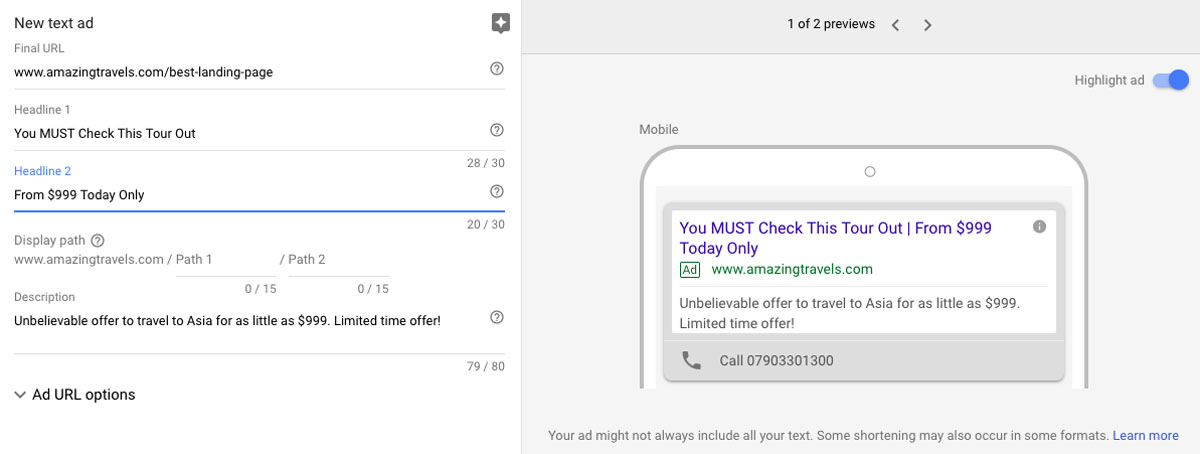
The description in the ad copy is also critical and should mirror the user’s objective – i.e. what does the user want to accomplish given the keyword they have typed in.
Phrasing your ad to appeal to that objective is a great strategy.
Other best practice tips for ad copy include emotional triggers like humour, anger or fear. Numbers, statistics and punctuation in headlines can also improve click-through rates.
QUICK EXERCISE
Building on our previous exercise, return to your Ad Groups and think of relevant keywords to target for each. Are you able to get enough search volume with exact-match keywords? Use Google Keyword Planner to map out your keywords and get a sense of keyword volume and competition.
Now think about the landing page on your website you would send traffic to for each Ad Group. Do your landing pages match the keyword intent of your Ad Groups? Do your landing pages match the overarching goal of your campaign?
In other words, are the Campaign(s), Ad Groups, Keywords and Landing Pages perfectly aligned?
If not, where is the alignment broken? Many tour operators will find that they don’t have a perfect landing page for every Ad Group.
Can you update your landing pages to make sure they align perfectly to your ad campaign? If not, try using a landing page service like ClickFunnels, Unbounce and Lead Pages to test and refine your ad campaign.
Analytics and Performance Evaluation
PPC advertising is not a static environment. In fact, it is constantly evolving. This makes measuring performance and refining campaigns over time very important.
Within the account, you will quite quickly get a sense of which ad groups and campaigns are performing the best. The aim should be to adjust keywords, ad groups and campaigns to wean out the losers and double down on the winners.
Google provides incredible real time data to see which ad campaigns; ad groups and keywords are performing the best. From the Campaign menu you are able to drill down into the performance of each ad group and keyword.
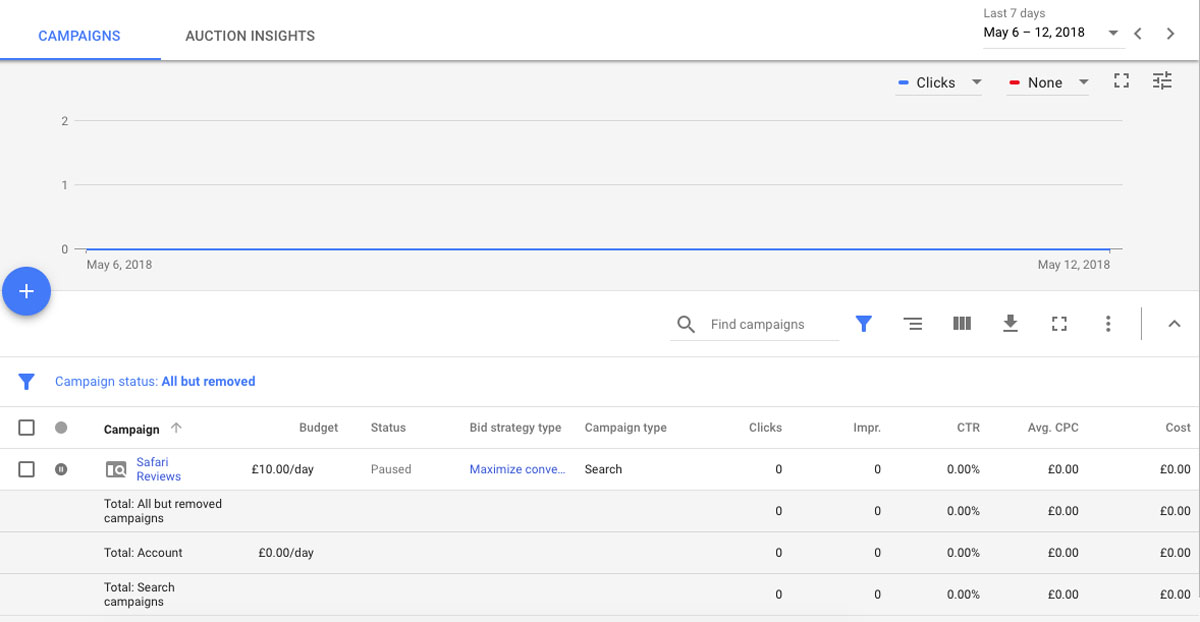
This process of adjusting, testing and readjusting is especially true on the landing pages and in the ad copy itself.
It is very common for advertisers to lose money with PPC when they start out. Many give up early and never touch advertising again, but for the select few who preserve and master the PPC hierarchy of needs, the path to success often looks like this.
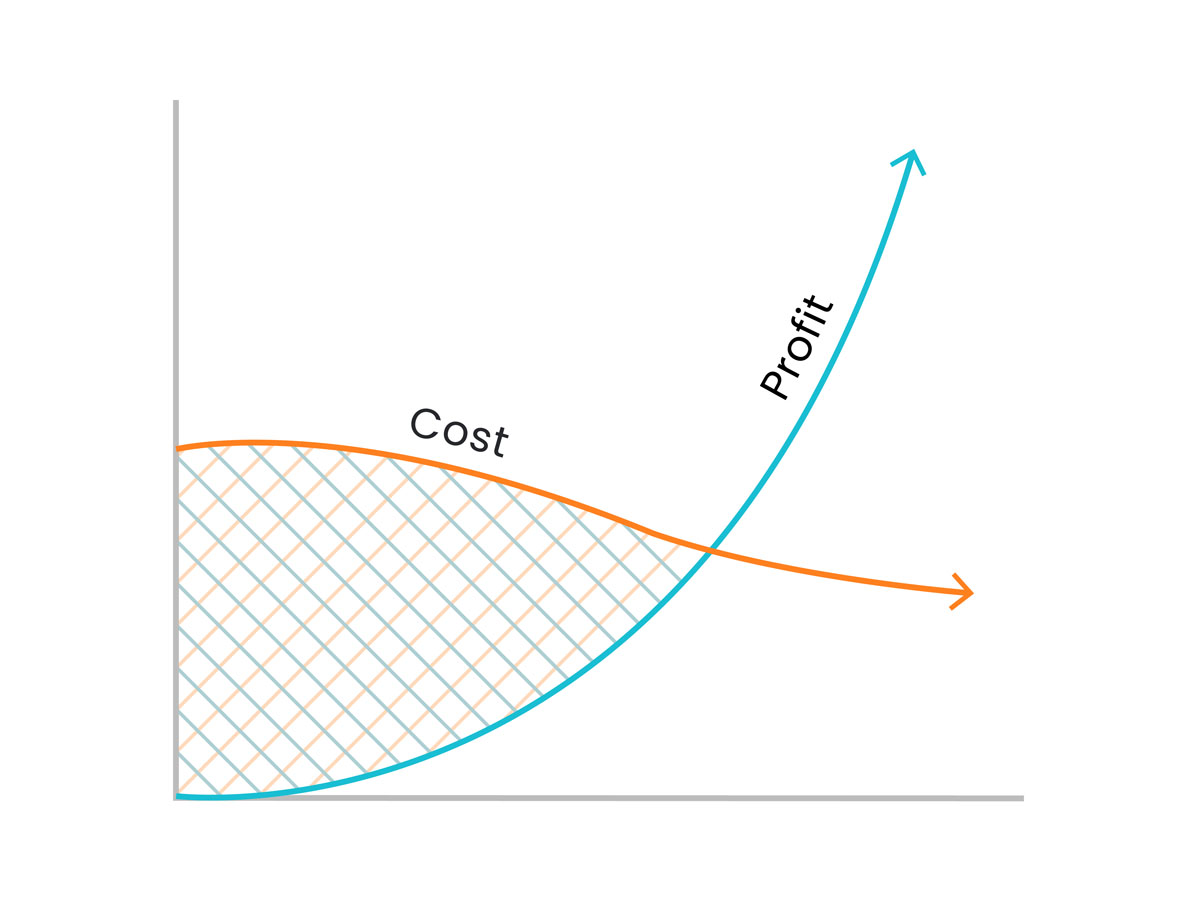
In other words, initially your costs can outweigh your profits. You can consider this period the learning, testing and refining stage.
After some time, though, you will develop insight to start removing ads that are underperforming and reinvesting in winning ad campaigns. Eventually, the profit line will cross the cost line and ROI will be predictable and scalable.
Retargeting
I’m sure you have had the experience of browsing the Internet for a product, let’s say curtains. The next day you open up your computer to read a popular news website and there, in the header or sidebar of the screen, is an advert for the curtains you were looking at the day before.
This is called ad retargeting or remarketing, and it is an incredibly powerful way to reach users who visited your website but did not convert.
According to analysts, only 2% of web traffic converts on the first visit. This means that there is a huge market opportunity to retarget the 98% of visitors who don’t convert right away.
Retargeting works through a technology that places some code on a user’s web browser to “follow” them around anonymously. The diagram below shows how it works.
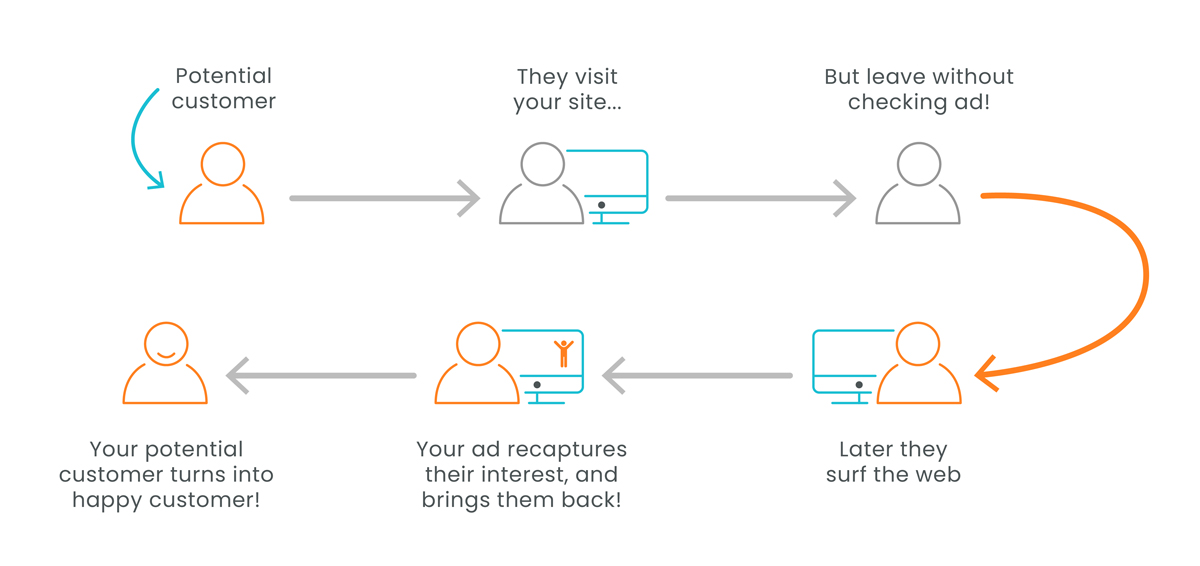
When it comes to PPC adverting on Adwords, retargeting is great as it gives an advertiser another chance to market to a potential customer at a much lower cost per click.
Google have an enormous network of publishers where it can place your ads. This is called Google Display Network, and is distinct from Google Search Network, in the sense that the ads don’t appear on a search result page, but on a publishers website instead.
Like for like, display network ads are generally less effective than search network ads, as the intent of the user is slightly diminished after they have clicked into a search result.
However, with retargeting the display network is highly attractive as the user has already been exposed to your products and services, and you are now having another go at convincing them to buy.
Setting up retargeting is relatively straightforward as all you need to do is place some basic Google tagging code on your site.
Once you have retargeting set up on your site, Google will start to build a remarketing list, which you can target with display ads.
For example, here is the travel operator, Intrepid Travel, retargeting an ad via Google’s publisher network.
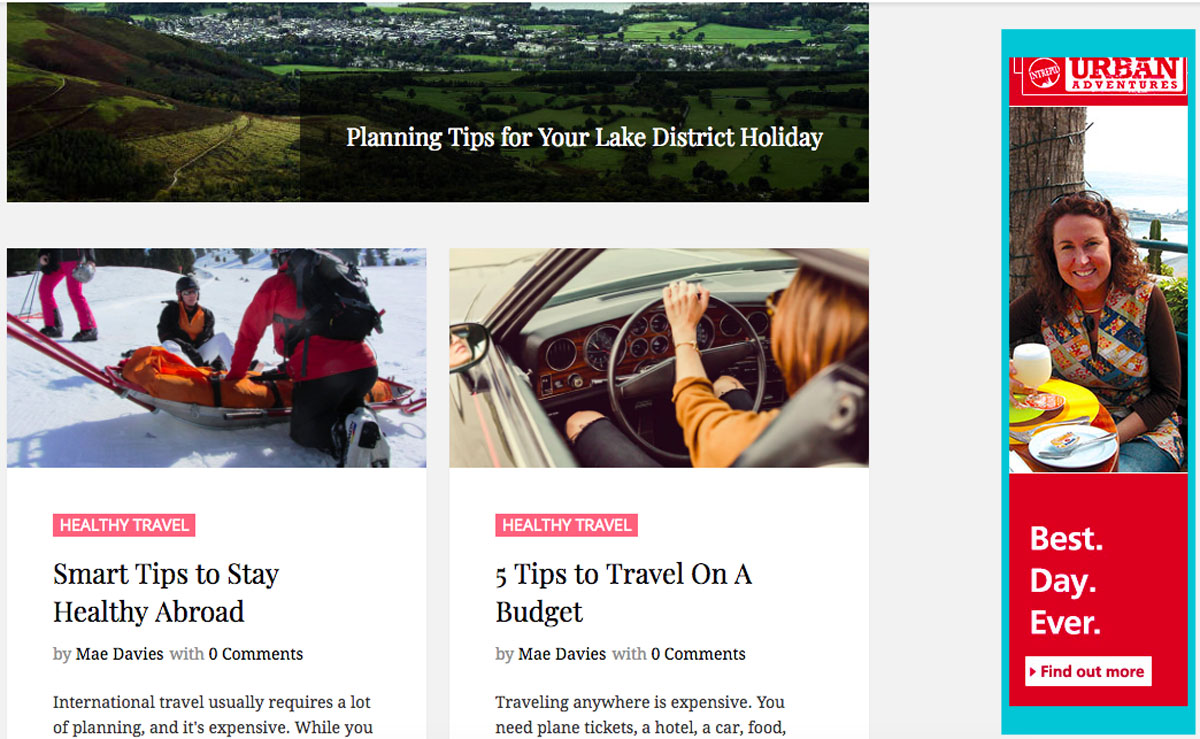
A winning retargeting campaign relies heavily on segmenting a retargeting list based on user behavior and aligning engaging ads with the right segmentation.
For example, the ad above is not retargeting just any old Intrepid Travel ad. It is retargeting a specific ad based on our previous browsing behaviour on their website. In this case we browsed Intrepid’s city tours, and now they are retargeting using their sister brand, Urban Adventures.
Suggested Reading
- To begin exploring retargeting we recommend you check out Google’s resources on setting up retargeting tags and building a remarketing list.
Summary
Google PPC advertising provides an opportunity for travel operators to test tour offerings, validate their service and generate loads of enquiries.
Over 90% of the world’s Internet users use Google’s search engine every day. A great Google advertising campaign begins with a clear understanding of the relevant and high-commercial-intent keywords that users are searching for.
Aligning an ad account via a well thought out campaign that brings together themed Ad Groups, Keywords, Ad Copy and Landing Pages is the key to success.
Retargeting users after they have visited your site provides a massive opportunity to move them down your sales funnel and convert them to customers.
However, due to high competition for the top spots in a Google search, an advertising campaign can be quite expensive. In the next article we look at Facebook Advertising, which applies a different mechanism to online advertising and can be a lot cheaper to get started with.
Did you enjoy this article? Get a FREE e-book: 150-page guide that covers everything from establishing a winning travel brand to delivering a market-leading service.
New resources, straight to your inbox
We’re committed to your privacy. WeTravel uses the information you provide to us to contact you about our relevant content, products, and services. You may unsubscribe at any time.



